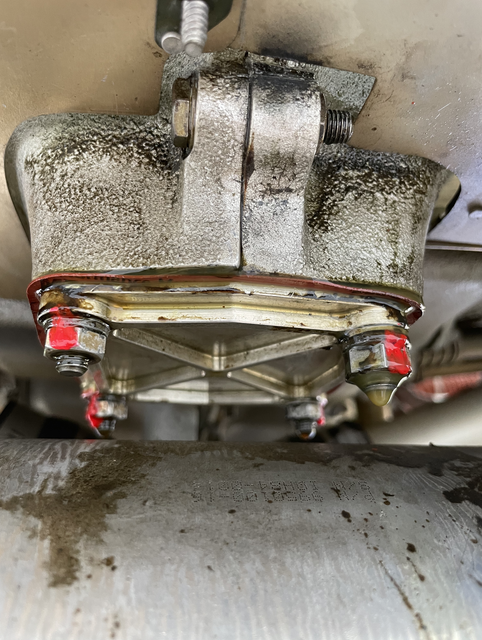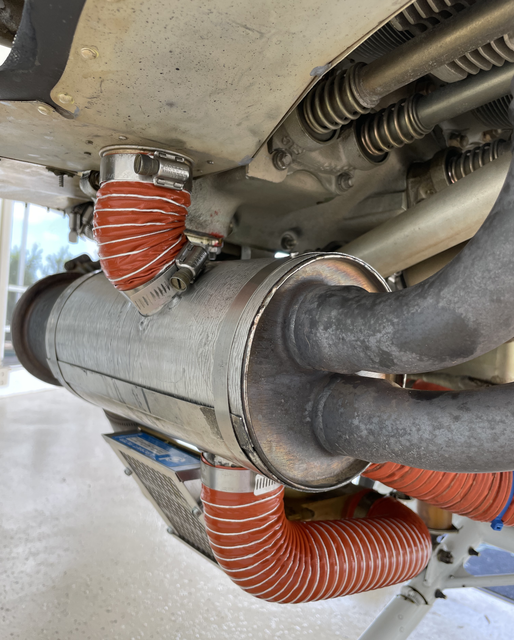"Compton traffic, Cessna 123 taking runway 25L, departing Straight Outta Compton"Not necessarily, they could be falling out when opening a door after a fly by shooting.
You are using an out of date browser. It may not display this or other websites correctly.
You should upgrade or use an alternative browser.
You should upgrade or use an alternative browser.
Burning smell on takeoff. Any suggestions?
- Thread starter kicktireslightfires
- Start date
kshaw
Pre-takeoff checklist
I had a major electrical fire in my Warrior about 25 years ago. I was not flying the plane at the time but the renter did an emergency landing in an open field. He said the smoke was affecting vision forward and made it hard to breath. The fire extinguished itself. The insurance company covered all the expense of new harnesses for the avionics but it took a few weeks to make the repairs. The shop could not give me a definitive cause for the fire.
texasclouds
En-Route
Fly it over a lake so you can easily extinguish the fire. And wear a body camera.
kicktireslightfires
Pre-takeoff checklist
- Joined
- Jun 11, 2020
- Messages
- 343
- Display Name
Display name:
kicktireslightfires
UPDATE
Pulled the engine cowling and chatted with an A&P. We suspect the leaking vacuum pump cover plate might be the culprit because it leaks oil directly onto the exhaust muffler. The burning smell in the cockpit did not register as smelling like burning oil to either myself, a CFI, nor a 20,000 hour pilot I went up with, but perhaps that's what it is. We found a bunch of oil on the bottom inside of the lower cowling when we removed it. My best guess at this point is, when the airplane rotates on takeoff, that causes the oil to then drip more aggressively right onto the exhaust (you can see in the photo that there are drips hanging from the screws and I'm imagining on rotation, that drips onto the exhaust). I actually just had this gasket replaced about a month ago because it was leaking. And now it's leaking again. And upon checking the engine logbook, this gasket was also replaced 8 years ago, just a year or two after the plane was brand new. So for some reason this damn cover plate doesn't want to seal. I almost wonder if there's any reason not to permanently seal it with some kind of high-temp sealant since the gasket does not seem to be doing the job for whatever reason.

Pulled the engine cowling and chatted with an A&P. We suspect the leaking vacuum pump cover plate might be the culprit because it leaks oil directly onto the exhaust muffler. The burning smell in the cockpit did not register as smelling like burning oil to either myself, a CFI, nor a 20,000 hour pilot I went up with, but perhaps that's what it is. We found a bunch of oil on the bottom inside of the lower cowling when we removed it. My best guess at this point is, when the airplane rotates on takeoff, that causes the oil to then drip more aggressively right onto the exhaust (you can see in the photo that there are drips hanging from the screws and I'm imagining on rotation, that drips onto the exhaust). I actually just had this gasket replaced about a month ago because it was leaking. And now it's leaking again. And upon checking the engine logbook, this gasket was also replaced 8 years ago, just a year or two after the plane was brand new. So for some reason this damn cover plate doesn't want to seal. I almost wonder if there's any reason not to permanently seal it with some kind of high-temp sealant since the gasket does not seem to be doing the job for whatever reason.

Skyrys62
En-Route
- Joined
- Apr 5, 2017
- Messages
- 3,726
- Location
- hopefully not at work
- Display Name
Display name:
Meet the Fokkers
Well there ya go..
take that annoying muffler off, and go fly. Problem solved.
Seriously though, hope you found it.
take that annoying muffler off, and go fly. Problem solved.
Seriously though, hope you found it.
kicktireslightfires
Pre-takeoff checklist
- Joined
- Jun 11, 2020
- Messages
- 343
- Display Name
Display name:
kicktireslightfires
Well there ya go..
take that annoying muffler off, and go fly. Problem solved.
Seriously though, hope you found it.
Ha! Wish I could do that! Yes, I hope this is the issue, too. I'm going to ask the A&P about just using some JB Weld high-temp silicon gasket to seal it because given the history I don't think replacing the gasket is going to fix the problem. Not sure why Continential didn't just seal this cover plate better to begin with. There's no need for the exit point on the engine so I don't see why they didn't just weld it shut.
Dan Thomas
Touchdown! Greaser!
- Joined
- Jun 16, 2008
- Messages
- 10,744
- Display Name
Display name:
Dan Thomas
Someone has overtightened the n uts on that cover and warped it. Take it off, straighten it, and install it with a new gasket and torque the nuts to the number specified in the overhaul manual. Gooping stuff over the seams is a really poor way to fix anything, an absolute last resort to avoid pulling the entire engine apart. And it usually doesn't work.
Dripping only on rotation? Not likely. There's so much airflow past that area...
Dripping only on rotation? Not likely. There's so much airflow past that area...
Floyd
Pre-Flight
You might want to replace the cover plate. As mentioned above that one is probably warped.
kicktireslightfires
Pre-takeoff checklist
- Joined
- Jun 11, 2020
- Messages
- 343
- Display Name
Display name:
kicktireslightfires
Thank you, I will relay to my A&P!
kicktireslightfires
Pre-takeoff checklist
- Joined
- Jun 11, 2020
- Messages
- 343
- Display Name
Display name:
kicktireslightfires
A&P took off the cover plate, said it's completely flat and not warped, but there was some old gasket stuck to it so he scrapped that off. He made a thicker gasket for it and reinstalled. Then I undertook the fun job of scrubbing out all the oil that had dripped all over the place. The entire inside of the muffler housing -- you know, the part where the cabin heat gets its heated air from -- was covered in oil that had dripped in there. So we took off the muffler housing and I cleaned it best I could. Now it makes sense to me because even with the cabin heat vent closed, I'm almost certain it's not air tight and the oil was probably burning off inside that housing and going straight into the cockpit. I can only imagine what would have happened if I pulled cabin heat and opened the valve. Probably would have been an overwhelming smell of burning oil. Cleaned everything up, reinstalled, and fitted some new SCAT hoses as well. Hopefully no more leak and no more smell.


Dan Thomas
Touchdown! Greaser!
- Joined
- Jun 16, 2008
- Messages
- 10,744
- Display Name
Display name:
Dan Thomas
I hope he didn't make that new gasket out of cork. That is the original vacuum pump mounting pad, and there is (probably) an oil pressure feed hole in the flange for the wet-style vacuum pumps. A cork gasket can blow out and you lose all your oil. Any gasket material that is too soft is just as bad.
From https://support.cessna.com/custsupt/contacts/pubs/ourpdf.pdf?as_id=16988 we read:

From https://support.cessna.com/custsupt/contacts/pubs/ourpdf.pdf?as_id=16988 we read:
PaulS
Touchdown! Greaser!
UPDATE
Pulled the engine cowling and chatted with an A&P. We suspect the leaking vacuum pump cover plate might be the culprit because it leaks oil directly onto the exhaust muffler. The burning smell in the cockpit did not register as smelling like burning oil to either myself, a CFI, nor a 20,000 hour pilot I went up with, but perhaps that's what it is. We found a bunch of oil on the bottom inside of the lower cowling when we removed it. My best guess at this point is, when the airplane rotates on takeoff, that causes the oil to then drip more aggressively right onto the exhaust (you can see in the photo that there are drips hanging from the screws and I'm imagining on rotation, that drips onto the exhaust). I actually just had this gasket replaced about a month ago because it was leaking. And now it's leaking again. And upon checking the engine logbook, this gasket was also replaced 8 years ago, just a year or two after the plane was brand new. So for some reason this damn cover plate doesn't want to seal. I almost wonder if there's any reason not to permanently seal it with some kind of high-temp sealant since the gasket does not seem to be doing the job for whatever reason.

I'm not so sure that oil is coming from that bottom plate gasket. I'd be very suspect of the vertical split, it looks like that has oil in it too.
Eric Hayes
Filing Flight Plan
- Joined
- Jul 4, 2018
- Messages
- 1
- Display Name
Display name:
BoNiac36
Do you still have the burning smell or did you figure out the issue?
RyanShort1
Final Approach
There is a flip side to this… there was an airplane that had an electrical issue that I flew and we did discontinue the flight and the problem was fixed, but for several flights afterwards certain angles of attack seemed to disturb leftover carbon that was difficult to clean up.I would NOT take off in a plane that has a burning smell.
I hated trying to guess if it was a new problem or simply the old smell coming back but it eventually went away.

